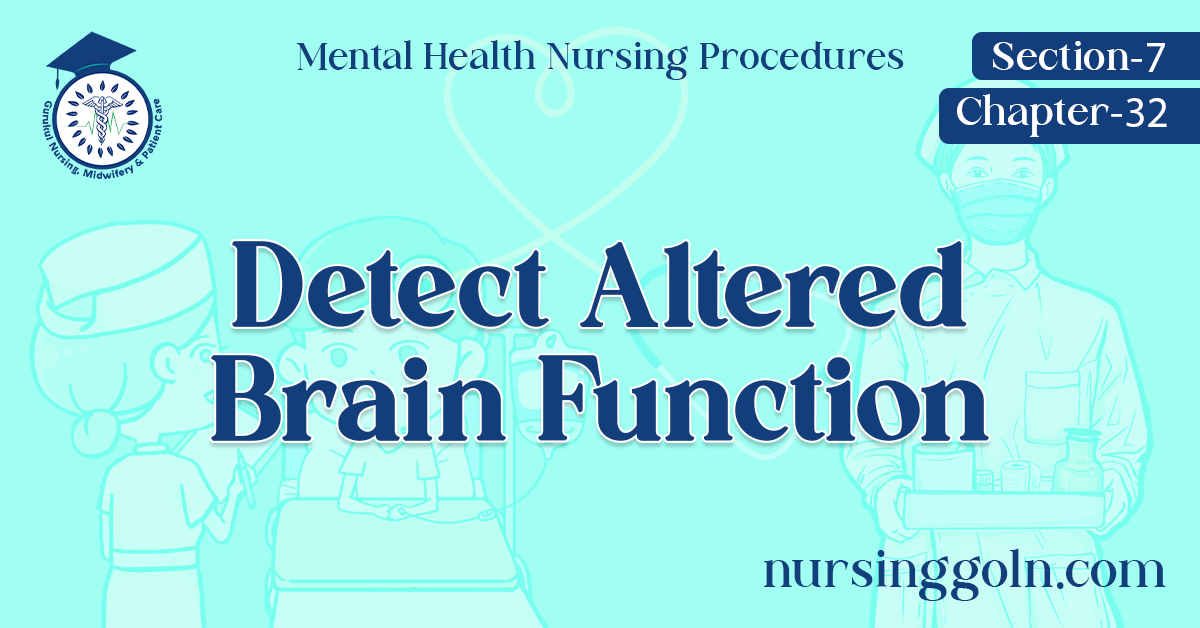Today our topic of discussion is Detect Altered Brain Function.
Detect Altered Brain Function

Diagnostic Procedures used to Detect Altered Brain Function
Several diagnostic procedures are used to detect alteration in biologic function that may contribute to psychiatric disorders.
Electroencephalography (EEG)
Technique: Electrodes are placed on the scalp in a standard- ized position. Amplitude and frequency of beta, alpha, theta and delta brain waves are graphically recorded on paper by ink markers for multiple areas of the brain surface.
Purpose: It measures brain electrical activity; identifies dysrhythmia, asymmetries, or suppression of brain rhythms; used in the diagnosis of epilepsy, neoplasm stroke, metabolic or degenerative disease.
Computed Tomography (CT)
Technique: Series of radiographs that are computer constructed into slices of the brain that can be stacked by the computer giving a three-dimensional image.
Purpose: Measures accuracy of brain structure to detect possible lesion, abscesses, areas of infarction or aneurysm. CT has also identified various anatomic differences in clients, with schizophrenia, organic mental disorder and bipolar disorder.
Magnetic Resonance Imaging (MRI) Technique:
Technique:A magnetic field surrounding the head induces brain tissue to emit radio waves that are computerized to provide clear and detailed construction of sectional images of the brain. No radiation or contrast medium is used.
Purpose: Measures anatomic and biochemical status of various segments of the brain; detects brain edema, ischemia, infection, neoplasm, trauma and other changes such as demyelination. Morphological differences between the brains of clients with schizophrenia and those of control subjects have been noted.

Brain Electrical Activity Mapping (BEAM)
Technique: Uses computed tomographic techniques to display data derived from EEG recordings of brain electrical activity that can be sensory evoked by specific stimuli, such as flash of light or a sudden sound, or cognitive evoked by specific mental tasks.
Purpose: Measures brain electrical activity; used largely in research to represent statistical relationships between individuals and groups or between two populations of subject (e.g. client with schizophrenia vs. control subjects).
Positron Emission Tomography (PET)
Technique: An injected radioactive substance travels to the brain and shows up as a bright spot on the scan; different substances are taken up by the brain in different amounts, depending on the type of tissues and the level of activity.
Purpose: Measures specific brain functioning, such as glucose metabolism, oxygen utilization, blood flow, and of particular interest in psychiatry neurotransmitter/receptor interaction.

Single Photon Emission Computed Tomography (SPECT)
Technique: The technique is similar to PET but a longer acting radioactive substance must be used to allow time for a gamma camera to rotate about the head and gather the data, which are then assembled on the computer into a brain image.
Purpose: Measures various aspects of brain functioning as with PET; has also been used to image activity or cerebrospinal fluid circulation.
Read more:
